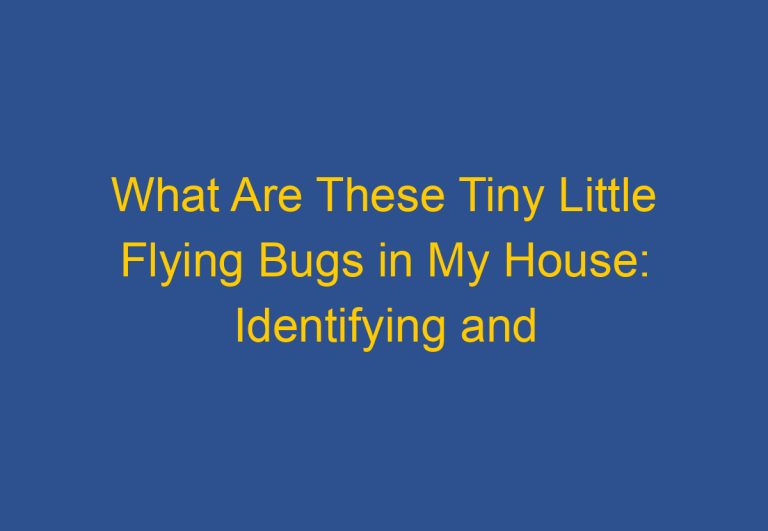What are These Super Tiny Bugs in My House? Understanding Common Household Pests
Super tiny bugs can be found in many homes and can be quite a nuisance. These bugs are so small that they can be difficult to see with the naked eye, and they can often go undetected until they become a problem. Many people wonder what these bugs are and how to get rid of them.
The first step in dealing with super tiny bugs in the home is to identify them. There are many different types of bugs that can be found in the home, and each one has its own unique characteristics. Some of the most common types of tiny bugs found in homes include stink bugs, pillbugs, and cockroaches. Identifying the type of bug is the first step in figuring out how to get rid of it.
Once you have identified the type of bug, it is important to take steps to get rid of it. There are many different methods that can be used to get rid of tiny bugs in the home, including traps, sprays, and natural remedies. It is important to choose a method that is safe and effective for both the bugs and the people living in the home. With a little bit of patience and persistence, it is possible to get rid of these tiny bugs and keep them from coming back.
Identifying Common Household Bugs
Household bugs can be a nuisance to deal with, and identifying them can be a challenging task. In this section, we will discuss the physical characteristics and behavior of common household bugs, as well as their habitats and infestation signs.
Physical Characteristics and Behavior
Bugs, ants, spiders, cockroaches, silverfish, bed bugs, fruit flies, carpet beetles, and other tiny creatures can all be found in homes. They come in different colors, shapes, and sizes, and have various physical characteristics that make them unique.
For example, ants have six legs and two antennae, while spiders have eight legs and multiple eyes. Cockroaches have a reddish-brown color and long antennae, and silverfish have a fuzzy appearance and long antennae as well. Bed bugs are tiny brown bugs that feed on human blood, and fruit flies are small black bugs that are attracted to ripe fruits and vegetables.
Habitats and Infestation Signs
Different bugs have different habitats and infestation signs. For example, cockroaches usually lurk in dark crevices, cupboards, and behind furniture, while bed bugs hide in mattresses, headboards, and bed frames. Fruit flies are commonly found in kitchens and pantries, and carpet beetles can be found in carpets, clothing, and upholstery.
Infestation signs can include visible bugs, droppings, and damage to fabrics or other materials. For example, carpet beetles can leave holes in clothing and carpets, and bed bugs can leave bloodstains on sheets and mattresses.
In conclusion, identifying common household bugs can be a challenging task, but by understanding their physical characteristics and behavior, as well as their habitats and infestation signs, homeowners can take steps to prevent and control infestations.
Prevention and Control Strategies
Sanitation and Home Maintenance
One of the most effective ways to prevent and control household pests is by maintaining a clean and well-organized home. Regular cleaning of the house, especially in areas where food is stored or prepared, can help prevent infestations. It is important to vacuum regularly to remove any crumbs or food particles that may attract pests. Dirty dishes should be washed promptly, and trash cans should be emptied regularly.
In addition, it is important to store food in tightly sealed containers and airtight containers to prevent pests from accessing it. Natural fibers, such as wool and silk, should also be stored in airtight containers to prevent damage from clothes moths. Damp places should be dried out, and dehumidifiers can be used to reduce moisture levels in the home.
Natural and Chemical Control Methods
There are several natural and chemical methods that can be used to control household pests. Diatomaceous earth, for example, is a natural product that can be used to control a variety of pests, including ants, bed bugs, and cockroaches. This substance is effective because it dehydrates the exoskeleton of the pests, causing them to die.
Traps can also be used to control pests. For example, sticky traps can be used to trap spiders and other crawling insects, while light traps can be used to trap flying insects. In addition, pest control experts can be consulted to provide professional pest management services.
Chemical control methods, such as pesticides, can also be used to control household pests. However, it is important to use these products with caution, following all instructions carefully. It is also important to keep in mind that some pests may develop resistance to certain pesticides over time, making them less effective.
In conclusion, preventing and controlling household pests requires a combination of sanitation and home maintenance, as well as natural and chemical control methods. By following these strategies, homeowners can keep their homes free from pests and prevent infestations.
Frequently Asked Questions
What are the tiny black dots I’m finding in my house?
Many people have found tiny black dots in their homes and wondered what they are. These dots are usually caused by small insects, such as fleas or bed bugs, which are difficult to see with the naked eye. The dots are actually the insects’ fecal matter, which can be a sign of an infestation.
How can I identify small, brown bugs in my home?
Small, brown bugs can be difficult to identify, but there are a few common types that are found in homes. Carpet beetles, for example, are small, oval-shaped bugs that are brown or black in color. They can often be found in carpets, furniture, and clothing. Another common type of small, brown bug is the bed bug, which is reddish-brown in color and feeds on human blood.
Why am I seeing tiny bugs that resemble poppy seeds?
If you’re seeing tiny bugs that resemble poppy seeds, they may be flea beetles. These bugs are small and black, and they feed on plants. They can often be found in gardens and on houseplants. Another possibility is that they are springtails, which are tiny insects that jump like fleas.
What steps should I take to eliminate tiny bugs in my home?
The first step in eliminating tiny bugs in your home is to identify the type of bug you’re dealing with. Once you know what you’re dealing with, you can take steps to eliminate them. This may involve cleaning and vacuuming your home, sealing up any cracks or openings where bugs may be entering, and using insecticides or other treatments to kill the bugs.
How can I determine what kind of tiny, barely visible bugs are in my house?
Identifying tiny, barely visible bugs in your house can be difficult, but there are a few things you can look for. You can try using a magnifying glass to get a better look at the bugs, or you can try catching one and taking it to a pest control professional for identification. You can also try searching online or in books for pictures and descriptions of common household bugs.
What causes an infestation of little bugs that look like specks of dirt?
There are many things that can cause an infestation of little bugs that look like specks of dirt. Some common causes include poor sanitation, moisture, and food sources. These bugs can often be found in kitchens, bathrooms, and other areas where there is food or water. To eliminate an infestation, it’s important to identify the source of the problem and take steps to eliminate it.










